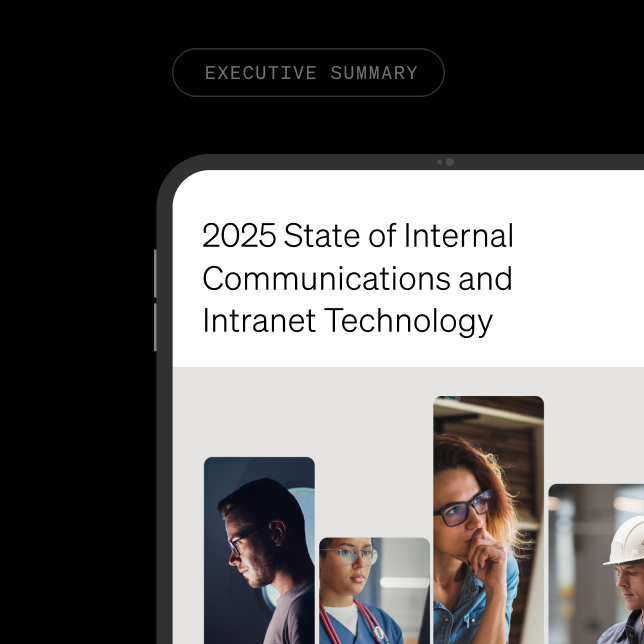Simpplr Research just fielded a survey on the state of internal communications. We’ll be sure to share the insights once the research is completed, but the preliminary results highlighted an issue plaguing most internal communicators.
The biggest challenge for internal communications and communicating with employees today is: “employees aren’t engaged or incentivized to partake in internal communications.” Admittedly, this is a difficult challenge. Landing corporate communications is hard because it’s not like our company news is ESPN or People Magazine. But part of it is on us: employees aren’t engaged because we haven’t sold them and we continue to make common communication mistakes, leading to poor communication.
Here are 12 common communication mistakes in the workplace:
Workplace Communication Mistake #1: Failing to promote your purpose
Most internal communications functions admit that they don’t have a clearly defined charter. Huge problem. Here’s the sad truth: most of your work will be discarded as noise if you establish what you do and don’t effectively let people know why you’re doing it.
Workplace Communication Mistake #2: Not communicating strategic priorities frequently enough
Most organizations don’t communicate frequently enough in general. But the real struggle lies in internally marketing your strategic priorities. We’ve all been there: we have a meeting once a quarter and then we go back to our day jobs. This is not enough! Communicating strategic priorities need to be more frequent than just once a quarter in meetings especially once you understand that employees are more engaged and productive when they have internalized purpose and strategy and understand how they align.
Workplace Communication Mistake #3: Not curating your messaging (and intranet)
Here’s a paradox. On one hand, most organizations don’t communicate frequently enough but their messaging platforms like the employee intranet are a confusing mess. Beat the drum, but constantly tend to your garden so messages are clear, consistent, and not drowned by other noise. This is important because messaging typically ties to your strategic priorities. If you have your strategic priorities aligned with your purpose, making sure your messages are curated should be a breeze.

Workplace Communication Mistake #4: Not communicating in a way that employees like to consume messages
It seems we’ve said this 1,000 times on this blog alone. Employees want news that is: new and plentiful, regular and timely, short and useful, and relevant and interesting. And where applicable, unique, clear, and inspiring. Also, employees don’t like to read much as they like to watch videos. In addition to the multimedia medium in which content is consumed, it’s important to think about the channels of consumption. Content consumption has shifted to mainly mobile usage. If you want to get a hold of your employees, make sure that mobile is part of your channel. Here’s an on-demand webinar on how we think mobile should be incorporated into your intranet strategy.
Workplace Communication Mistake #5: Lacking transparency
Management always thinks we can’t handle the truth. A culture that’s honest and shares bad news is better than one that hides information from employees. Withholding information creates a culture of skepticism and mistrust that eventually chips at the trust of your employees. Employees that lack trust in management hurts your bottom line.
Workplace Communication Mistake #6: Assuming employees “get it”
Chances are that not all of your employees have their MBAs or understand strategy at a higher level. Droning about strategy, margin goals, strategic initiatives will land on deaf ears. This is where internal communications is critical for effective communication. Like a good journalist, dumb things down wherever necessary to increase widespread knowledge amongst the majority.
Workplace Communication Mistake #7: Failing to repeat your message
Marketers often make the same mistake: you put your message out there and assume the world will absorb it. We are bombarded with so much information on a daily basis that it’s extremely easy to forget important messages. Important messages need to be constantly repeated, usually across multiple mediums, just like a multi-channel campaign.
Workplace Communication Mistake #8: Not communicating fast enough
The world hates vacuums. If you’re not getting employee communications out fast enough, then gossip, rumors, and fake news will take over. This really hurts employees that don’t always assume positive intent and fear the worst. This is especially critical for time-sensitive news.

Workplace Communication Mistake #9: Not squashing fake news
Fake news spread like wildfires and it threatens your company culture. You can forget about improving employee engagement if your company can’t effectively squash fake news. Your company needs processes to keep an ear to the ground and quickly address misinformation in a transparent, non-threatening, and efficient manner.
Workplace Communication Mistake #10: Not praising employees and encouraging dialogue
It’s the right thing to do and it improves employee engagement. But there’s more: these tactics both change the communications dynamic from static edicts from on high to engaging two-way collaboration. If you want employees to internalize your communication, let them be part of it! Effective communication is always a two-way street. If you want improvement within your organization, it’s important to open up the channels of communication between you and your employees.
Workplace Communication Mistake #11: Not being fun
Although necessary, a lot of business communications are “boring.” But it doesn’t all have to be that way. Intermixing fun with strategic is the secret to building a community around employee communications and getting them to engage with your intranet. Find what engages your employees and create a balance of fun and engaging content with strategic messages. For more ideas, download our eBook: The Definitive Intranet Content Playbook.
Workplace Communication Mistake #12: Not getting feedback
You may be the lucky one that has omniscient control of how employees consume feedback, what channels they prefer, how they’re driving employee engagement and business results, and if the messages are landing. Everybody else needs to ask from time to time.
What you need to know about employee communication and retention
The point is, communication is extremely important to the backbone of your company and its culture. We often have goals to improve communication in the workplace, but it’s important to avoid the common mistakes that prevent effective communication. Simpplr Research conducted a study based on in-depth Glassdoor analysis: Glassdoor Data on Employee Communication & Retention. Download the eBook to learn the impact of key cultural drivers for engaging employees and the impact it has on employee retention.
















